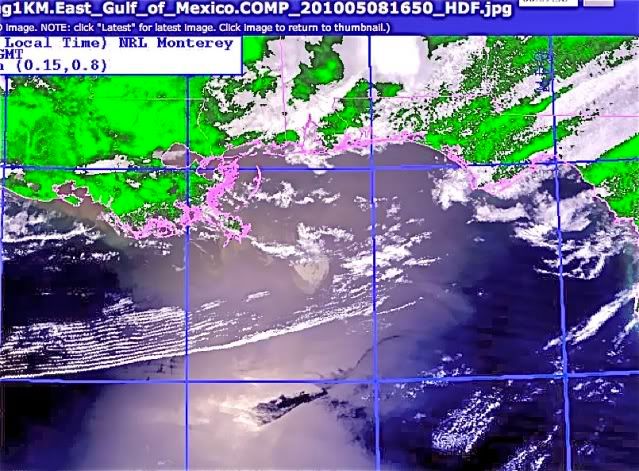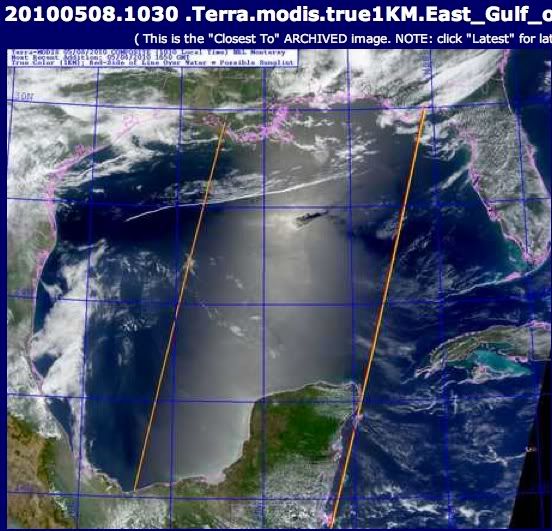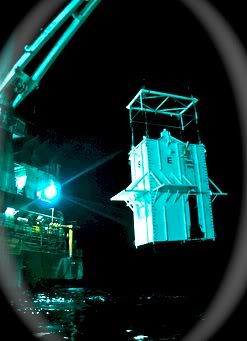(noon. – promoted by ek hornbeck)
Remember Blue Popsicles ?
The Pipes on the Outhouse Froze. photo, Navy. color, ARC.
From tonight’s NOAA Daily Situation Update May 8 2010:
http://response.restoration.no…
The experimental containment dome was successfully positioned over the leaking riser pipe last night, but then had to be removed after a large volume of ice-like methane hydrate crystals accumulated inside of the structure. These crystal hydrates blocked the flow of oil and threatened to lift the dome off the sea floor. The 4-story containment structure now sits on the seafloor next to the leak while experts consider ways to solve this issue.
/snip
The westerly movement of the oil is expected to continue though the forecast period with the western edge nearing Atchafalaya Bay on Monday.
url for Saturday’s govt. JPA press conference http://www.dvidshub.net/?scrip…
BP Spokesperson Doug Suttles on the status of the “containment dome” (He is the last speaker on this video) this is a partial transcript
Yesterday we lowered it to the seafloor and began to place it over the source of the leak. As we stressed, never been done before at this depth, big technical challenge with the hydrate formation.
{The containment dome is plugged with frozen gas hydrate} Hydrate = Gas combines w/ water at certain temp and pressure, a mix of water and gas which form a crystal similar to ice. This formed inside of the top of the dome dome, which is currently sitting on the seabed while we evaluate options to deal w/ the hydrate issue, we believe it will take at least 2 days to look for opportunities to try to overcome this challenge
Other options being considered:
Activities to create a stoppage or plug up existing BOP (Blow Out Preventer)
2nd BOP or similiar valve on top of the existing equipment, will be gathering additional data over next 48 hours
Our Relief Well: is drilling at 9000′ feet and making progress, actually ahead of plan
Booms: approaching a million feet of boom deployed 2.3 mil feet add Brazil Spain China UK and US, 1 million feet from new manufacturers, 25,000 feet new made for this per day anticipated, other countries are sourcing.
We have oil around Chandeleur island, clean up assessment teams are responding to that (evaluation ?)
17,000 barrels of oil water mix skimmed off , 5 oil burns, can’t burn today (weather).
Priorities continue with:
stop flow ,minimize impact, environmental and economic, and keeping public informed of our activities.
embed for video conference here:
Lt. Cmdr. Wyman, Rear Adm. Mary Landry, Lars Herbst and BP representative Doug Suttles brief the media Sat 5/8/2010 video by your govt. nice job, Lt. Sagisi
per this 2006 link, frozen gas hydrates “also form a vital constituent of the ocean beds.” They form at low gas temperature and high gas pressures. There is methane trapped within the “ice” lattices, which makes them dangerous.
http://www.oilgae.com/blog/200…
Willy Ritch http://willyritch.com/?p=333 mentions a recent (Oct 2006 ) conference held in Scotland in which scientists discussed the concept and future of gas hydrates. The consensus at the meeting apparently was that gas hydrates contain twice the total of all the world’s current fossil fuel reserves. Another interesting nugget is mentioned in this post: “Scientists say (gas hydrates extraction) must be done very carefully or much of the gas could be released into the atmosphere with serious adverse consequences. At least one scientist thinks escaping methane from gas hydrates could explain the mythology of the Bermuda triangle.” This apparently is because extracting gas hydrates could result in a massive amount of gases bubbling up to the ocean, thus decreasing the density of water and sinking ships which were earlier floating safely. The gas is also highly explosive which could result in explosions around airplanes flying in that area….. hmmm….. interesting, bermuda triangle’s mystery could be, might be because of gas hydrates, what do you think?
More on the dangers of methane gas hydrate’s here, and what happens when you try to thaw them out:
Making Fire From Ice: The Independent UK 18 Oct 2006
http://www.independent.co.uk/n…
Gas hydrate, despite its potential as a low-carbon fuel, could wreak untold damage on the atmosphere. Due to the very high methane content in its structure, a dissociation of methane hydrate into its constituent parts, methane and water, could lead to staggering levels of the gas being released into the atmosphere.
With this grim caveat in mind, major countries around the world are now in a race to discover how to produce energy from methane hydrate. But the challenges involved are manifold. “Hydrate reservoirs are different from conventional reservoirs,” says Professor Tohidi. “In traditional reservoirs, the energies are freed. Here, the source of energy is solid. Because hydrates are like ice, they are already in formation. So, to produce from them, you have to turn hydrates into water and gas: you have to dissociate them.”
How is it done?
“One technique is to decrease pressure, another is to increase temperature, and a third is to introduce alcohol, a little like one would do with antifreeze,” says Professor Tohidi.
“Yes, the challenges are great,” says Professor Tohidi. “One major issue arises because these hydrates are basically part of the sediment structure. And if you dissociate the hydrate, there will be emptiness where there was once hydrate. These are shallow sediments – hydrate occurs at about 600m below the sea bed – so [the sediments] are not consolidated. So, if you remove some of the substance from them, they might subside. And, if they subside, the sea bed will collapse. Then, the gas could escape freely, which could be incredibly harmful. This is why we are trying to replace one hydrate with another, but, as I said, there are challenges.
So the wreck of the BP Deepwater Horizon is blowing lots of highly explosive methane out with that crude oil, nearly a mile down.
And per an “anonymous” verified BP witness to the blowout,
http://www.rigzone.com/news/ar…
this well had a bad history of producing lots of gas. It was touch and go a few times, and was not terribly uncommon. You’re always going to get gas back from a well.
Mother Nature every now and then kicks up. The pressures that we’re dealing with out there, drilling deeper, deeper water, deeper overall volume of the whole vessel itself, you’re dealing with 30 to 40 thousand pounds per square inch range — serious pressures.
Meanwhile, the dispersants (a mixture like a soap and chemical gasoline or mineral spirit solvent) being sprayed over the oil on the surface and at the leak have been coming under increasing scrutiny. Not only is the Corexit brand dispersant being used toxic to the tiniest forms of ocean coastal water wildlife such as mysidae shrimp and other crustaceans and tiny fish such as silversides, http://www.mblaquaculture.com/… , which form the essential food for larger fish, birds, turtles, porpoises and whales, but,
http://www.bangkokpost.com/new…But environmentalists have warned that dispersants like Corexit were also nefarious to sea life.
“Those products don’t make the oil go away,” Gulf Coast Research Laboratory marine biologist Joe Griffitt told AFP. “It just falls to the sea bottom. That’s where you’ll find the sediments and the larvae. So the toxic effect is double.”
Blog which was sounding early on the hazard of Corexit: Energy Tough Love Blog http://censys.org/blog/?p=1640
EPA page on Corexit , which shows that when mixed with #2 fuel oil, it takes a lower parts per million ( amount of mixture in the water ) to become toxic to the little fish they tested it on:
http://www.epa.gov/OEM/content… notice how it doesn’t say anything about what happens when it is used at extreme pressures and temperatures cold enough to freeze methane.
Corexit 9500, made by Nalco Energy Services in Sugarland, Texas, contains petroleum distillates, propylene glycol, and “organic sulfuric acid salt.” Handlers are supposed to wear pvc gloves, protective clothing, and chemical splash goggles. For eye contact, flush with water for 15 minutes. For skin contact, wash with soap and water. If ingested, do not induce vomiting, contains petroleum distillates. If conscious, washout mouth and give water to drink, get medical attention. If inhaled, get medical attention.
If released into the environment, it is expected to distribute to the air <5%, water 10 to 30%, and to the Soil/Sediment 50 to 70%.
http://docs.google.com/viewer?…
Corexit is applied at the ratio of 2 to 10 gallons per acre, or 1 gallon for every 10 to 50 gallons of oil. (that would be 4000 gallons a day of dispersant if they were going to treat 200,000 gallons of oil per day) http://www.smartplanet.com/bus… By last Wednesday, they had put 140,000 gallons of dispersant into the Gulf.
BP’s CEO, Tony Hayward, last week on May 5th, described the dispersant spraying scene at the blowout as a military battle.
http://www.theaustralian.com.a…
“Let’s be very clear,” he said of the slick. “We’re containing it … The reason it’s not getting to the beaches is because we’re containing it. We don’t know if we can continue to contain it, but for the moment we are.”
The unprecedented use of dispersant chemicals at the source of the leak a mile under water “seems to be working very effectively”, he said, describing an armada of surface ships working with an “air force” of aircraft spraying similar chemicals.
“I’m using military rhetoric because that’s what we’re fighting, a battle, and we’re going to win,” he said.
Robert Kennedy Jr. is already representing claimants suing BP and is pointing out that the oil is merely being put into the water column, not being cleaned up, which will still damage fisheries.
These are the NRL Monterey Satellite images for today, Saturday, of the Gulf of Mexico
••• 
5/8/2010 Saturday, The Gulf of Mexico, BP Oil Spill, day 18, center of picture, now wrapping around to the west side of the Mississippi River Delta, oil color enhanced lavender- brown, clouds white, green is vegetation, pink is shoreline. photo NRL Montery, colors by ARC.
*
*
•••• 
5/8/2010 Saturday, The Gulf of Mexico, true color. Shoreline drawn in pink. photo NRL Monterey
No, the oil is not going to go away. Neither is the methane. Neither is the dispersant.


24 comments
Skip to comment form
Author
….. methane was accidentally released into the atmosphere because of global climate change?
Don’t smoke in the lavatory.
One of the only half-way decent programs on NPR which has become a kind of polished version of Fox News, and I heard some guy who had a website for engineers and was collecting solutions to this problem. The impression I got is that is that neither BP nor the American gov’t was interested in opening up the floor to the collective expertise of engineers particularly those that think outside the box.
The whole matter should never be in BP’s hands. The fact it still is another example of this administration’s lack of concern for anything other than power for its own sake. Open up the process! This is a collective problem not a BP problem! The entire world will suffer because of this and we need to find some open-source solutions. This is a very serious issue and the government and the media seem indifferent to it as they are indifferent to our collective fate. Everyone is working for their own narrow interest–as long as their vacation home on Martha’s Vinyard isn’t going to suffer they’re fine.
nothing will shut it off short of a relief well.
and the gulf will die.
and what happens next is anyone’s guess regarding the effect on the oceans.
anyone who claims to know is full of it.
i do believe global climate will be affected as the gulf stream is a climate engine.
http://www.whoi.edu/page.do?ci…
we are already fracked beyond belief.
and we will have to do without the oil coming through nola to the whole mid-west when the port shuts down and/or that thingy that collects all the oil and routes it on land because they can’t bring it into the Mississippi.
that the leak is about 210,000 gallons per day, but some industry sources are estimating that it is really 5 times that – upwards of a million gallons a day or more.
BP’s main concern now appears to be ‘containment’: meaning keep it off the beaches and out of the public eye, while they try everything they can think of to find a way to ‘recover the oil.
if it is leaking a million gallons a day the means there is today more than 17 million gallons of oil in the water, most of it under the surface, while it increases a million gallons a day.
What that is doing to the gulf ecosystem I have no way of estimating, but ‘catastrophic’ is the one word that comes to mind.
BP has said it may take them three months to cap it, if it can be capped at all.
By that time there will be at these estimated rates 90 million gallons of oil in the water, or about 10 Exxon Valdez’ worth, while it will continue to gush.
And it will hit the beaches, as well as get sucked out to the Gulf Stream by the Loop Current.
As of October 2009, 35 states use the death penalty.
I am opposed to it for people.
But since corporations now have the same rights as people, I’d support it for corporations like BP. Maybe by dismemberment?
And I’d like to see all of BP’s assets seized, and used to cover cleanup costs even if cleanup is not possible, as well as used to reimburse people who lose their livelihoods, fishers, tour operators, etc, and to cover medical treatment and bills for people poisoned by this.
When the still Sea conspires an armor
and her sullen and aborted
currents breed tiny monsters
true sailing is dead
awkward instant
and the first animal is jettisoned
legs furiously pumping
then still green gallop
and heads bob up
poise
delicate
pause
consent
In mute nostril agony
carefully refined
and sealed over
They didn’t have a plan, and the one they came up with was clearly inadequate. If they were worried about temperatures, and they should have been, if they were worried about methane, and they should have been, they should have heated the inside of the unit and ventilated it.
And now what? We’re going to think about how to fix it?
I’m sorry. They are killing the gulf if not the planet. They really need to get this stopped. There should be discussions with everybody who has an idea to get this to work.
Found a nice description of the chemical properties of dispersants. Basically, it’s a detergent. http://www.itopf.com/spill-res…
I do have a question I have not yet been able to find an answer to. Given that oil reservoirs are natural, and do exist in various places such as the beneath the surface of the ocean, and that nature is subject to a variety of violent phenomena such as earthquakes and volcanoes, I’m curious as to whether natural phenomena could crack one open, and whether this has happened in the past, and if there is any sort of evidence that this might have occurred.
Given that the fossil record is pretty spotty, this might be hard to discover evidence for. Nevertheless, I’ve read that there are a number of unexplained extinction events. I wonder if anyone credible has tried tying the two together yet.